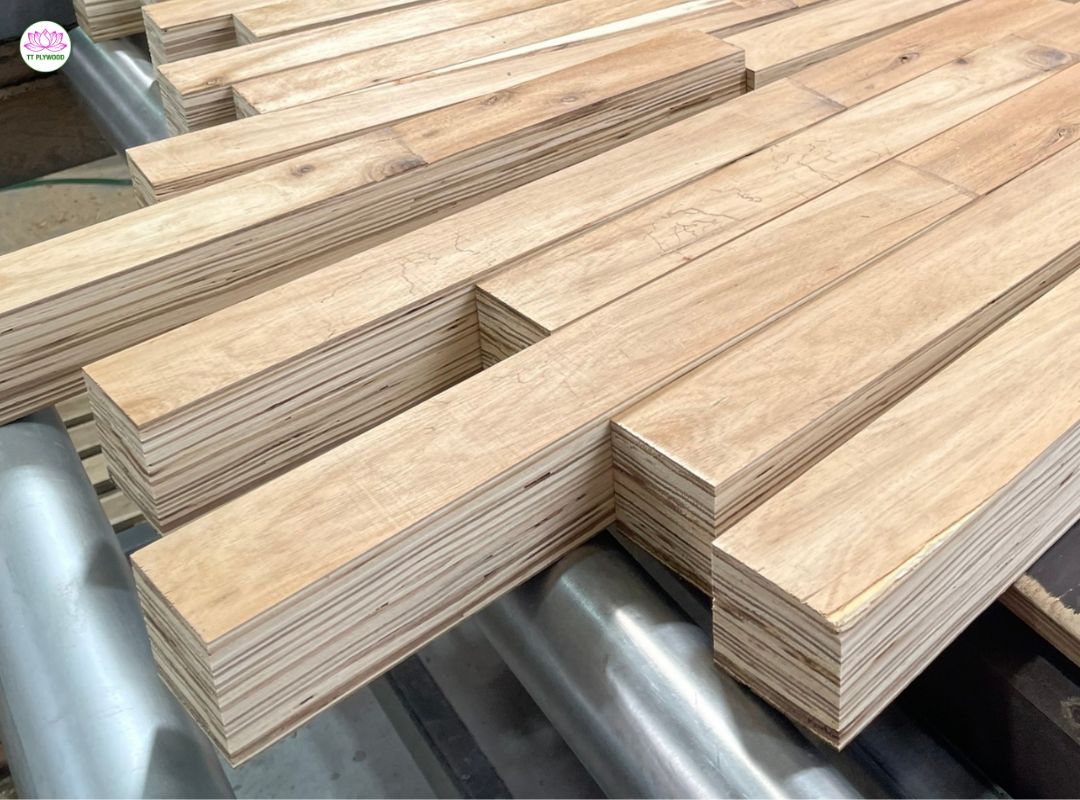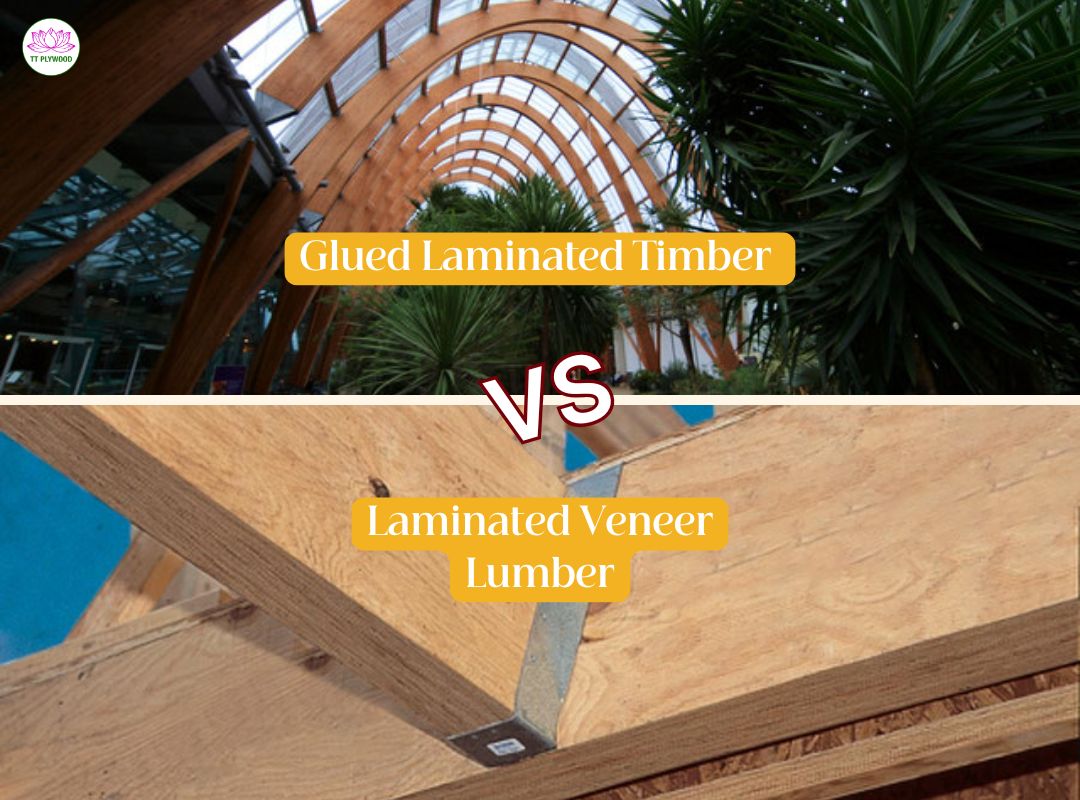-
-
-
Total payment:
-

LVL vs Glulam Beams: Strength, Cost & Use Cases Compared
Posted by Thanh Uyên at 06/08/2025
As engineered wood becomes a cornerstone of sustainable and high-performance construction in both the EU and US, two materials stand out: Glulam (Glued Laminated Timber) and LVL (Laminated Veneer Lumber). While both products are designed to outperform traditional sawn timber, they are not interchangeable. Understanding their differences is crucial when selecting the right material for beams, headers, joists, or architectural elements in residential and commercial buildings.
In this article, we will compare Glulam and LVL across key performance metrics, cost, sustainability, and real-world applications so you can confidently choose the best timber product for your project.

What Is Glulam?
Glulam is an engineered wood product made by bonding together multiple layers of sawn timber using structural adhesives. All layers, or laminations, are oriented in the same grain direction, allowing glulam to offer high load-bearing capacity, dimensional stability, and long spans.
Common Glulam Applications:
- Beams and columns for large-span structures
- Curved or arched roofs in architectural designs
- Bridges and halls requiring aesthetic exposed timber
- Sustainable construction certified to EN 14080 or ANSI A190.1
Glulam is not only structurally efficient but also visually appealing, making it ideal for exposed timber applications in churches, auditoriums, and modern eco-homes. In European markets such as Germany, Sweden, and Austria, glulam is widely used for both its aesthetics and sustainability profile.
What Is LVL?
LVL, or Laminated Veneer Lumber, is also an engineered wood product but is constructed by bonding thin wood veneers under heat and pressure. These veneers are aligned in the same direction to maximize strength and uniformity.
Common LVL Applications:
- Headers and beams in wall openings
- Floor joists and roof rafters
- Rim boards and I-joist flanges
- Multi-residential and light-frame construction
LVL excels in applications where straightness, consistency, and long lengths are required. It is less likely to warp, shrink, or twist compared to solid lumber, and is widely used in the United States and Canada in both residential and light commercial buildings. Products are typically manufactured according to APA standards and recognized under major building codes.

(LVL - Laminated Veneer Lumber)
LVL vs Glulam: Side-by-Side Comparison
| Feature | Glulam | LVL |
|---|---|---|
| Composition | Bonded sawn timber laminations | Bonded wood veneers |
| Strength | Very strong in bending and compression | Extremely strong and uniform in all areas |
| Maximum Span | Up to 30+ meters (custom production) | Up to 24 meters, depending on thickness |
| Aesthetic Finish | Suitable for architectural, exposed design | Typically hidden, not used for aesthetics |
| Fire Performance | Chars predictably, maintains load-bearing | Moderate fire resistance |
| Sustainability | Often FSC/PEFC certified; low embodied carbon | FSC/PEFC available; efficient wood use |
| Cost | Medium to high | Medium, often more cost-effective |
| Manufacturing Standards | EN 14080 (EU), ANSI A190.1 (US) | APA PRL/PRR guidelines, ANSI standards |
| Applications | Curved or architectural beams, columns | Straight load-bearing beams, headers, joists |
While both materials are high-performing, glulam has an aesthetic and span advantage, whereas LVL wins in dimensional precision and cost-efficiency for framing.
Structural Performance
In terms of strength, both LVL and Glulam outperform traditional sawn lumber. However, their structural behavior differs slightly due to their construction. Glulam beams are ideal for bending strength and perform well in applications requiring long, uninterrupted spans. Their cross-sections can also be customized for unique load conditions or architectural effects.
LVL, with its uniform veneer layers, offers high compressive and tensile strength, making it excellent for repetitive framing components like floor beams or headers. Because of its dense and homogenous composition, LVL is especially effective in load transfer over short to medium spans where appearance is not a priority.
Visual Appearance
One of the most significant differences between LVL and glulam lies in their appearance. Glulam is frequently used in applications where timber is visible and plays an architectural role. With a sanded finish and clean lamination lines, glulam can be stained or left natural to enhance the aesthetics of a space.
LVL, on the other hand, is almost always hidden behind drywall or sheathing. Its industrial appearance is not designed for exposure, and it typically comes in a rougher finish.
Span and Shape Capabilities
Glulam offers greater flexibility in terms of size and shape. Manufacturers can produce curved, arched, or tapered beams, which makes glulam especially suitable for unique rooflines, bridges, or open-plan structures.
LVL is limited to straight sections. It comes in standard rectangular shapes and lengths, though custom dimensions are available. While it provides excellent strength over long spans, it cannot be curved or shaped like glulam.

Fire Performance
In fire situations, glulam offers superior performance thanks to its charring behavior. As it burns, the outer layers form a char that protects the inner core, allowing it to retain load-bearing capacity longer than steel or unprotected lumber.
LVL also provides acceptable fire resistance, especially in thicker sections. However, because it is denser and composed of thin veneers, its charring behavior is different and may result in a faster degradation rate than glulam unless protected or treated.
Sustainability and Environmental Considerations
Both glulam and LVL are available with FSC or PEFC certification, which ensures that the wood is sourced from responsibly managed forests. Glulam is often considered slightly more sustainable due to its lower adhesive-to-wood ratio and lower embodied energy per unit strength.
LVL is also efficient in material use. Because it utilizes veneers, it can make use of smaller, faster-growing trees and maximize yield from each log. This makes it a practical choice in terms of resource efficiency, especially for builders targeting green building certifications like LEED or BREEAM.
Cost Considerations
From a pricing perspective, LVL is generally more cost-effective, particularly in high-volume, standardized applications such as floor systems and wall framing. It is produced in bulk and stocked in common dimensions, reducing both material and labor costs on site.
Glulam is typically more expensive, especially when customized shapes or architectural finishes are required. However, its ability to serve both structural and aesthetic functions can reduce the need for additional materials or finishes, which may offset the higher upfront cost.
Code Compliance in the EU and US
Glulam and LVL are both widely recognized under major building codes. In the EU, glulam must comply with EN 14080 and may carry CE markings. In the US, both products fall under the IBC and IRC codes. LVL is typically evaluated under APA PR-L and PR-R standards, while glulam is recognized under ANSI A190.1.
Project owners and architects should ensure that all supplied products come with proper documentation, performance certifications, and meet local code requirements, particularly for public buildings or export-sensitive markets.

Frequently Asked Questions (FAQ)
Q1: Which is stronger: Glulam or LVL?
Both are stronger than traditional lumber, but their strength depends on application. Glulam excels in bending and long spans, while LVL provides excellent uniformity and is ideal for short to medium spans and repetitive framing.
Q2: Can LVL be used in exposed applications like Glulam?
No. LVL is typically not suited for visible use due to its industrial appearance. Glulam is preferred for exposed or decorative applications.
Q3: Is Glulam more sustainable than LVL?
Both can be sustainable when sourced responsibly. Glulam may have a lower embodied energy per strength unit, but LVL uses smaller trees and maximizes raw material efficiency.
Q4: Which one is more fire-resistant?
Glulam generally offers better fire performance due to its predictable charring behavior. LVL performs well too but may degrade faster if not properly protected.
Can I replace steel with glulam or LVL?
In many structures, yes. Glulam and LVL are increasingly used as sustainable and cost-effective alternatives to steel in beams, trusses, and frames, especially in modern timber construction projects.
Conclusion
Choosing between glulam and LVL depends on the goals and specifications of your project. If your focus is architectural beauty, long spans, and exposed timber with strong sustainability credentials, glulam is likely your best option. If you're building a residential or commercial structure where consistency, cost, and strength are key, LVL will likely deliver the best performance.
Both materials are essential to modern timber construction and can help reduce the carbon footprint of your buildings while offering excellent structural integrity.
Looking for certified glulam or LVL products for your upcoming project in Europe or North America? TT Plywood supplies high-quality engineered wood with full FSC certification and compliance with EN and ANSI standards. Whether you need architectural glulam beams or high-performance LVL framing, our team is ready to support your goals.
Get in touch today for pricing, technical documentation, and tailored supply options. Let’s build smarter and more sustainably together.
Hotline/WhatsApp/Line/Kakao: +84 32 694 2288
Email: info@ttplywood.com
Website: https://ttplywood.com/










